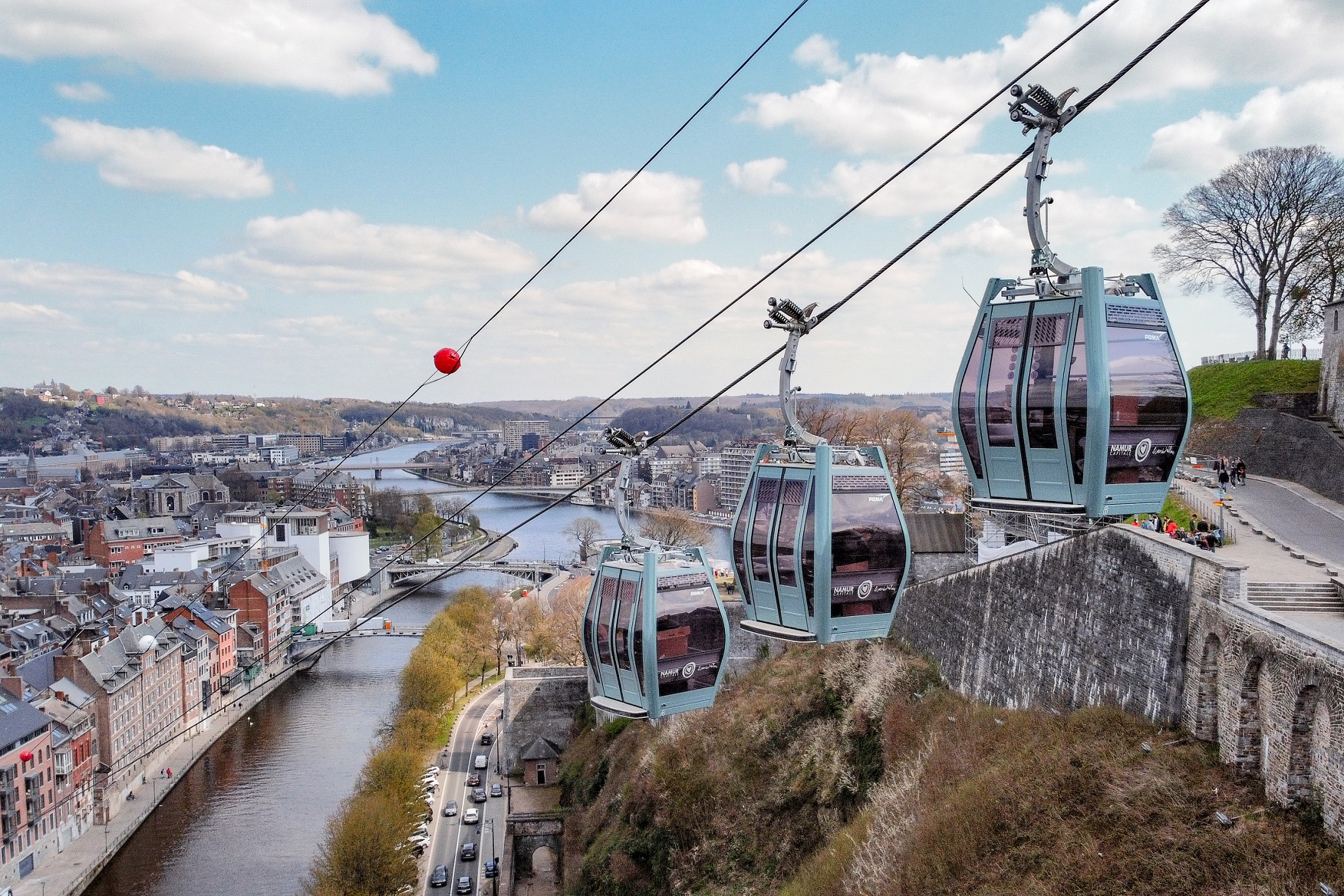Strategically founded where the Sambre river flows into the Meuse en route to the North Sea, Namur has been a city fought over throughout history. There is much to see along the rivers, within the old city and on the outskirts. Walking, biking trails and multiple modes of transport make it easy to see everything – although exercise of some kind is recommended to accommodate eating through this foodie city!
Like a sentinel, the Citadel of Namur overlooks the city at the confluence of the rivers. It is as if this fortification, one of Europe’s largest and oldest dating back to the 1400s, still guards Wallonia’s capital.
Namur’s fortified history goes back to the year 908, when it was a pre-Roman oppidum (fortified town) as the residence of the counts of Namur. The counts built a castle where the citadel sits today and remained there until the dukes of Burgundy took over in 1421. When France incorporated Burgundy in 1678, the now-fortified citadel became a strategic military base, most notably during the sieges of Namur in the War of the Grand Alliance (1689–97).
After Napoleon’s defeat in 1815, the Dutch took control of Namur and rebuilt the citadel: about 90 percent of its visible parts today date from this time. But by the end of the 19th century, nine concrete forts were built around Namur to relieve the citadel of its former duties. King Leopold II transformed it into a resort with a hotel, games stadium and open-air theatre, which still exist today.
Gleaming atop the citadel is ‘Searching for Utopia,’ a sculpture of a giant, golden turtle ridden by controversial Belgian artist Jan Fabre (a new sign points out his 2022 conviction of violence against women, condemns it and raises awareness about the issue). The citadel, which can be accessed via staircases or a new cable car, features the Terra Nova Visitor Centre in the former barracks with the history of Namur and its famous fortification. Facing the Terra Nova is the Esplanade with exhibitions promoting digital technologies in Namur.
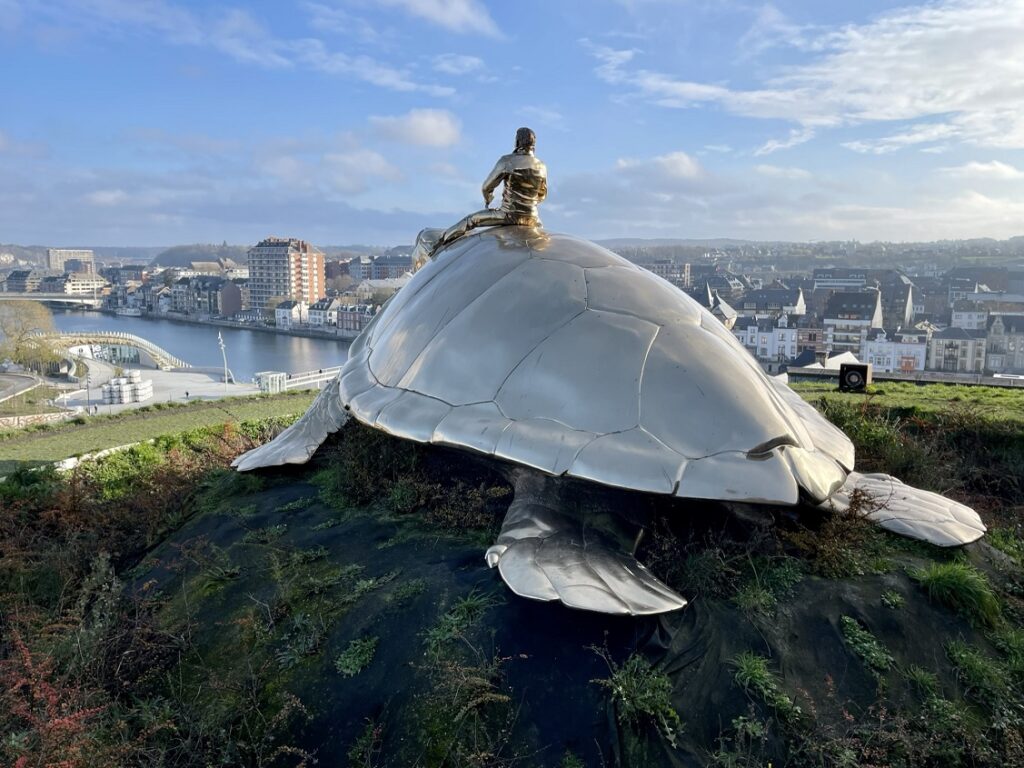
View of the river and Searching for Utopia
Underground passages built between the 16th and 20th centuries are still intact, and now include light and sound installations. Napoleon dubbed the citadel and its 7km of passages the “termite mound of Europe.” There are also plentiful walking trails above ground, green space and spectacular views overlooking the rivers. Fun surprises on the citadel include a perfumery, gallery, the Château de Namur hotel and garden, and restaurants.
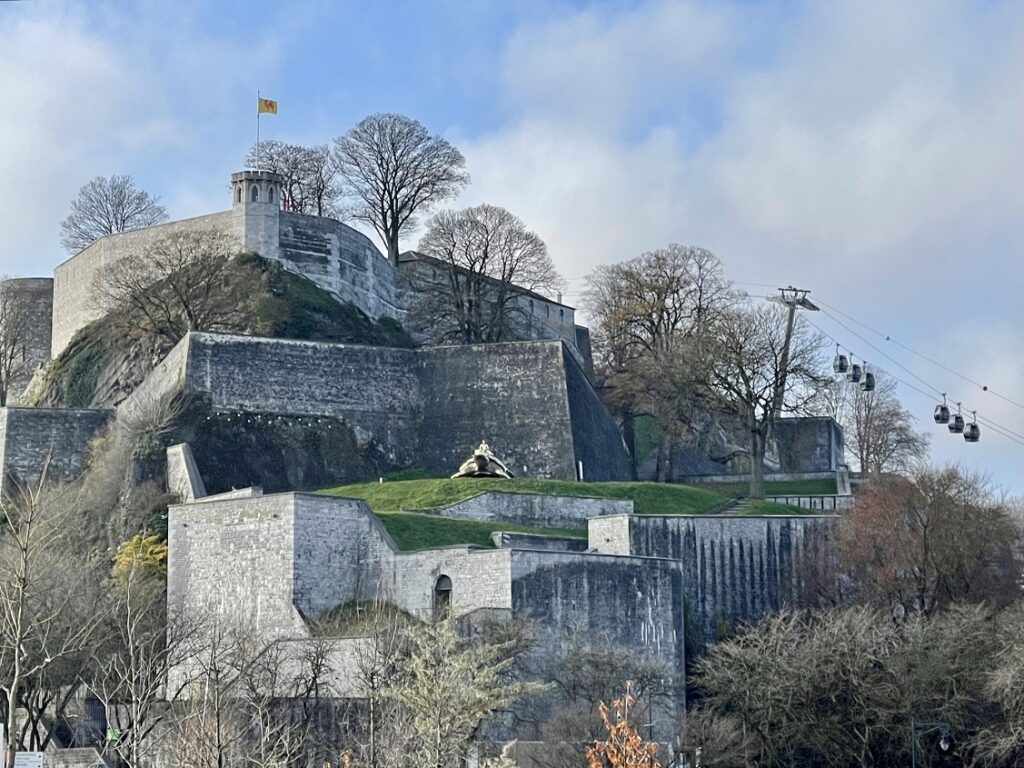
The Citadel
Another military relic in Namur is The Arsenal, built in the late 1600s as a logistics warehouse, food and fodder store during the sieges of Namur. Used by the Belgian army in World War II, it is now a restaurant and conference room facility for the University of Namur, the best-known of the city’s five universities.
Folklore
Beyond its military past, Namur is also steeped in centuries of folklore. Best known are its “échasseurs,” two teams of stilt walkers dressed in red and white, who have jousted with each other since 1411. The Mélans on yellow and black stilts represent the old city, while the Avresses on red and white are the new town and suburbs. Their jousts, which have entertained the likes of Charles V, Louis XIV and Napoleon, were added to UNESCO’s list of Intangible Cultural Heritage of Humanity in 2021 – and they’re equal opportunity, so in 2022, the first women’s joust in history took place.

Échasseurs, or stilt walkers
Les Alfers Namurois are flag throwers in 17th century costumes. They were established more than 60 years ago when King Baudouin visited Namur.
Les Masuis et Cotelis Jambois are a throwback to when the nearby Masuis people tended grapevines and Cotelis people grew hops. The ‘Frairie des Masuis et Cotelis Jambois’ folk band was founded in 1960 with about 40 dancers and musicians dressed in 18th century garb.
Les Molons de la Royale Moncrabeau are philanthropic singers who have collected money for the poor with their songs since 1843. They perform concerts on an enormous cart wearing colourful costumes and playing traditional instruments as well as rarer ones like kazoos. Their motto is “pleasure and charity,” which is written on their traditional shirts. Besides singing, the Molons tell funny lies and jokes to make people laugh. They even organize contests to determine the best liar of the year.
Along the rivers
Several worthy sights in Namur lie along the Sambre and Meuse Rivers. Three sides of the citadel face these rivers and a newly opened cable car crosses the Sambre to take people from Place Maurice Servais to the Esplanade (10am to 5pm daily).
In front of the massive citadel at the confluence of the Meuse and Sambre Rivers lies Le NID (Namur Intelligente et Durable), a space for public debate about challenges like climate change and clean energy. Its brasserie terrace facing the confluence has one of the best views of the city. Formerly called the Grognon, which refers to a stone with a pig snout shape that came from the old access gate, Le NID showcases the stone at its entrance. In May 2020, the confluence was connected via a cyclo-pedestrian bridge called L’Enjambée to the other side of the Meuse River, the town of Jambes.

Halle al'Chair
The Wallonia Parliament is based on the banks of the Meuse in a 17th century building. Visitors can enjoy spectacular views of it from across L’Enjambée and get a look inside with 1.5-hour guided tours (free but must be booked at least two weeks in advance). Further along the Meuse is the Casino of Namur.
On the Sambre, you can find Le Delta, a modern performing arts centre, and the 16th century Halle al’Chair building. Halle al’Chair will reopen later this year as the Namur Tourism Office. Le Delta, Namur’s house of culture, built for the Brussels World Fair in 1958, offers fantastic rooftop views of the citadel and confluence.
The boats L’Olympia, Croisières Namur and Les Namourettes (whaleboats, July-August only) let visitors see Namur and surrounding areas by water. For example, a restored 11th century bridge that crosses the Meuse 7km from Namur is where King Albert I fell to his death while rock climbing in 1934. Les Capitaineries de Namur across the Meuse near the casino rents stand-up paddle boards, including giant ones for 4-8 people; seven-person boats; and canoes or kayaks for visitors to explore the river on their own. Rentals are available April 15 to Oct. 15.
Gastronomy
People don’t just eat in Namur, they dine. Known for taking their time, the Namurois have plenty of excellent eateries, particularly featuring Belgo-French specialities, take-out indulgences like waffles and chocolate, and unique Namur products such as Biétrumé nutty caramels.
As the gastronomic centre of Wallonia, it’s no surprise that Namur’s symbol is edible: a snail. Called petit-gris de Namur, snails are a signature part of local gastronomy. Avisance, a hot puff pastry filled with minced meat, is the city’s version of a burrito without veggies.
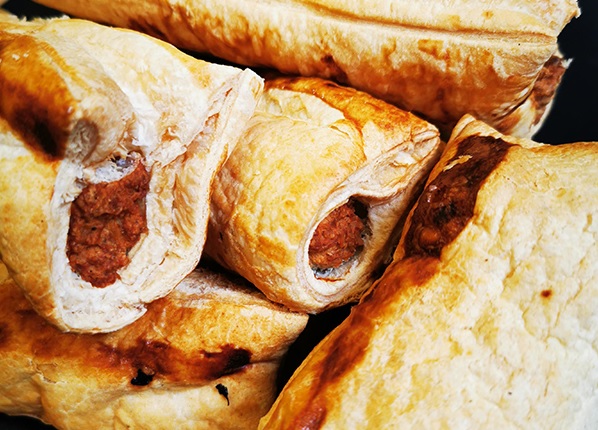
Avisance
Namur is also known for microbrews from its own Brasserie de la Houppe to nearby Brasserie du Clocher in a former chapel and Brasserie du Bocq, which make the brands Houppe (its logo is fighting stilt walkers), Philomène, Blanche de Namur and Gauloise. The first two brasseries offer tours.
Made in Namur, a self-service bistro on the citadel, serves and sells these beers along with other local beverages, such as rum flavoured with Biétrumé and melon- and strawberry-flavoured gins. La Noiseraie walnut factory on Namur’s outskirts sells oil and aperitifs, while the Bister factory in nearby Achêne produces three types of mustard.
Berry-based products are inspired by the nearby village of Wépion, which has been known for strawberry production since 1880. It is also home to the kitschy Musée de la Fraise (Strawberry Museum), which has displays about the fruit’s history, gastronomy, folklore and culture as well as a strawberry garden (April-Sept) and shop selling a range of strawberry products from jam to Peket Fraises (strawberry eau de vie) and Le Cochonnais, a pig pink strawberry-cream liqueur.
Architecture
Despite several invasions over the centuries, Namur has preserved architectural landmarks like the Belfry, a UNESCO World Heritage Site built in 1388. Formerly known as Saint-Jacques Tower, it became the Belfry in 1746 after the original tower exploded during the siege of Namur by Louis XV.
Architecturally noteworthy churches include St. Aubain cathedral, a Baroque giant from 1559 that was rebuilt in the mid-1700s by an Italian architect to resemble St. Peter’s Church in Rome, and Saint-Loup Church designed in 1621 with red marble columns inside.

Saint-Loup Church
Les Bateliers centre, which includes the Museum of Decorative Arts, a French garden and the Archaeological Museum of Namur (closed for renovation), is in a former mansion of the Counts de Groesbeeck and Marquis de Croix. This 18th century building is impressive unto itself, particularly when seen from the garden. The Archaeological Museum, one of the oldest in Belgium, is connected to the other museum via a stunning glass pedway (it also contains some of the country’s most important artefacts from the Paleolithic era to the Middle Ages. While currently closed, it still supplies artefacts for temporary exhibitions.)
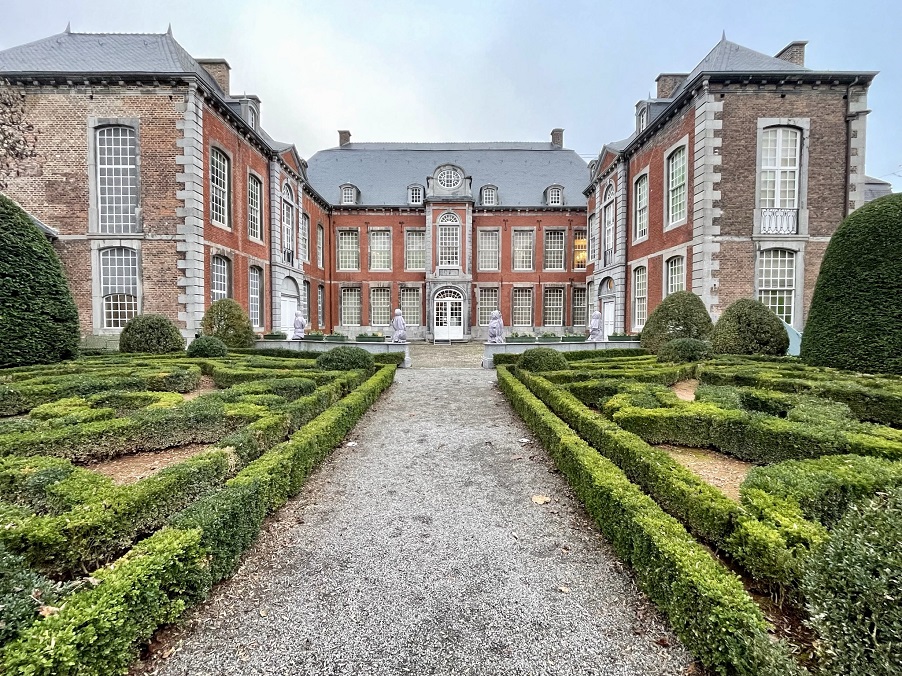
Les Bateliers
Contrasting styles are seen in the Theatre of Namur – one of the last Italian-style theatres in Europe dating back to the 1860s, which was renovated in 1998 – and Art Deco Cinema Cameo, on Carmes street. Other Art Deco examples can be found in Galerie Wérenne across from the train station and nearby Rue des Croisiers.
Art and culture
Namur illustrator and painter Felician Rops (1833-98) is memorialised in an eponymous museum featuring the largest collection of his works in the world. A controversial and provocative artist best known for illustrations and sketches tinged with sexual obsessions, he nonetheless had the respect of contemporaries like Auguste Rodin, James Ensor and Vincent van Gogh. A cycle route in Namur retraces the footsteps of the artist beyond the museum.
The Museum of Ancient Arts of Namur (TreM.a) in the former 18th century Hotel Gaiffier d’Hestroy, features artworks from the Middle Ages and Renaissance and one of the seven wonders of Belgium: the Treasure of Oignies. The latter has about 40 silver and gold pieces from the 12th and 13th centuries. St. Aubain’s Cathedral also has treasures, such as a golden crown and an altar from 1217, showcased in the Diocesan Museum within the cathedral.
Public sculptures are dotted around the city, including a golden angel trumpeting at Place de l’Ange, folkloric characters next to the Bourse at Place d’Armes, stilt walkers at the Jean-Baptiste Brabant roundabout and a large flying dragon on the banks of the Meuse. Since 2017, Namur has been sprinkled with 45 miniature businessmen about to jump, created by Spanish sculptor Isaac Cordal.

The snails of Djoseph and Françwès in La Place d'Armes
The tourist office offers a street art map to find them all (several are on the walls of City Hall). There are also nearly 20 street art murals, including the Fresco of the Walloons behind City Hall, which overlooks the mayor’s garden, and on the side of Villa Balat and its neighbouring building across L’Enjambée.
Bicycle-powered, covered rickshaws and motorised tuk-tuk carts can be hired for 30 and 60-minute tours. The hour-long tuk tuk ride goes 18km along the Meuse to the Wépion Strawberry Museum, across from Dave Island in the middle of the Meuse, the largest island in Belgium. Tours are even available by Segway, e-scooter, Vespa and glider plane.
For those who want exercise, the Namur Tourist Office has more than 200km of walking trails from 5km to 30km each. GPS-based tourist running trails can be accessed via runnincity.fr. There are also e-bikes for hire and plenty of biking trails, including the RAVeL (Réseau Autonome des Voies Lentes), nearly 1,500km of non-motorised paths, mainly along old railway lines and towpaths.
A free app via VisitWallonia.be offers discounts on Namur tourist attractions.
SEE
Here are recommended annual events in Namur with 2023 dates:
- Retrospective of Press Photographers Jan 19-Feb 12, Galerie du Beffroi.
- Torchlight Walks Feb 10-11, March 17-18, Nov 24-25 and Dec 15-16, Citadel.
- Namur in May May 18-20, Fairground, an arts festival with 100 free or paid events.
- Namur Music Festival June 30-July 16, Saint-Loup Church and Namur Concert Hall. Ancient and baroque music with riffs of jazz, tango and world music.
- Namur Marathon and Semi-Marathon April 4, along the Sambre and Meuse.
- Wallonia Festivals Sept 9-18, celebrating Walloon culture with concerts, folklore shows and surprises.
- Namur Circus Festival Oct 23-30, Citadel Esplanade.
- KIKK Festival Oct 26-29, showcasing digital and creative cultures.
SAVOUR
- Le Grill: A cosy restaurant on the first floor of Les Tanneurs hotel offers gourmet dishes at reasonable prices, specialising in grilled meats.
- Side: A fine-dining restaurant in Château de Namur is run by culinary students from the Provincial Hotel School of Namur.
- Panorama: An indoor-outdoor restaurant with a fantastic view atop the citadel and Belgian chef Yves Mattagne’s cuisine to match.
- Brasserie François: Parisian-style brasserie specialising in local products, including Zeeland mussels.
- Brasserie de la Confluence: In Le NID, this glassed-walled restaurant’s seasonal and sustainable menu is a showcase for local producers.
INDULGE
- La Maison de Desserts: Bakery with both a tearoom and shop to enjoy decadent cakes, tarts and pastries.
- Le Glacetronome: An artisanal ice creamery located just over the cyclo-pedestrian bridge L’Enjambée in a building with jungle street art.
SIP
- Botanical by Alphonse: Gourmet cocktail bar in central Namur that makes its own juices, infusions and syrups with plants grown in an adjacent greenhouse.
- Brasserie Fred: Restaurant bar offering wine in an elegant setting.
- Café Nomade: A clandestine nook at the back of the Boreal boutique for coffee or brunch.
- Bodart: Cozy brasserie at Place de l’Armes, also offering coffee and yummy pastries.
- Le Ratin-Tôt: Namur’s oldest café, dating back to 1616 for taking in a beer and history.
STAY
- Les Tanneurs: Renovated tannery that became one of the city’s best value hotels. It has 37 modern rooms and two excellent restaurants, L’Espièglerie and Le Grill.
- Château de Namur: Four-star boutique hotel with 24 rooms and five suites surrounded by a beautiful Scented Garden and terrace. Bar and fine-dining restaurant run by culinary students.
- Villa Balat: Stunning bed and breakfast on the banks of the Meuse with three suites and an enclosed garden for an intimate stay.
- La Noiseraie: Country guesthouse on the outskirts of Namur with four peaceful rooms, a restaurant, vegetable garden, spa and even a walnut factory.
- Arcadia Peniche: A houseboat for rent on the Meuse with four luxury en suite cabins to accommodate up to eight people year-round. Includes large living room, fully equipped kitchen and bicycles and kayaks for rent.
SHOP
- Parfumerie Guy Delforge: Atop the citadel, a long-time perfumery using locally grown flowers and other plants to create scents for women and men. Workshop tours are offered Monday to Saturday at 15:30.
- La Vielle Forge: A gallery near the perfumery with ceramics and paintings by artist Veronique Henri.
- Fait Main: A boutique in the Delta cultural centre’s stunning rotunda featuring handmade crafts by about a dozen local artists.
- Les Badasses: A “conscious fashion boutique” on the Charles barge along the Meuse River.
- Craft Beer Market: a shop and tasting room of artisanal beers from around the world.

